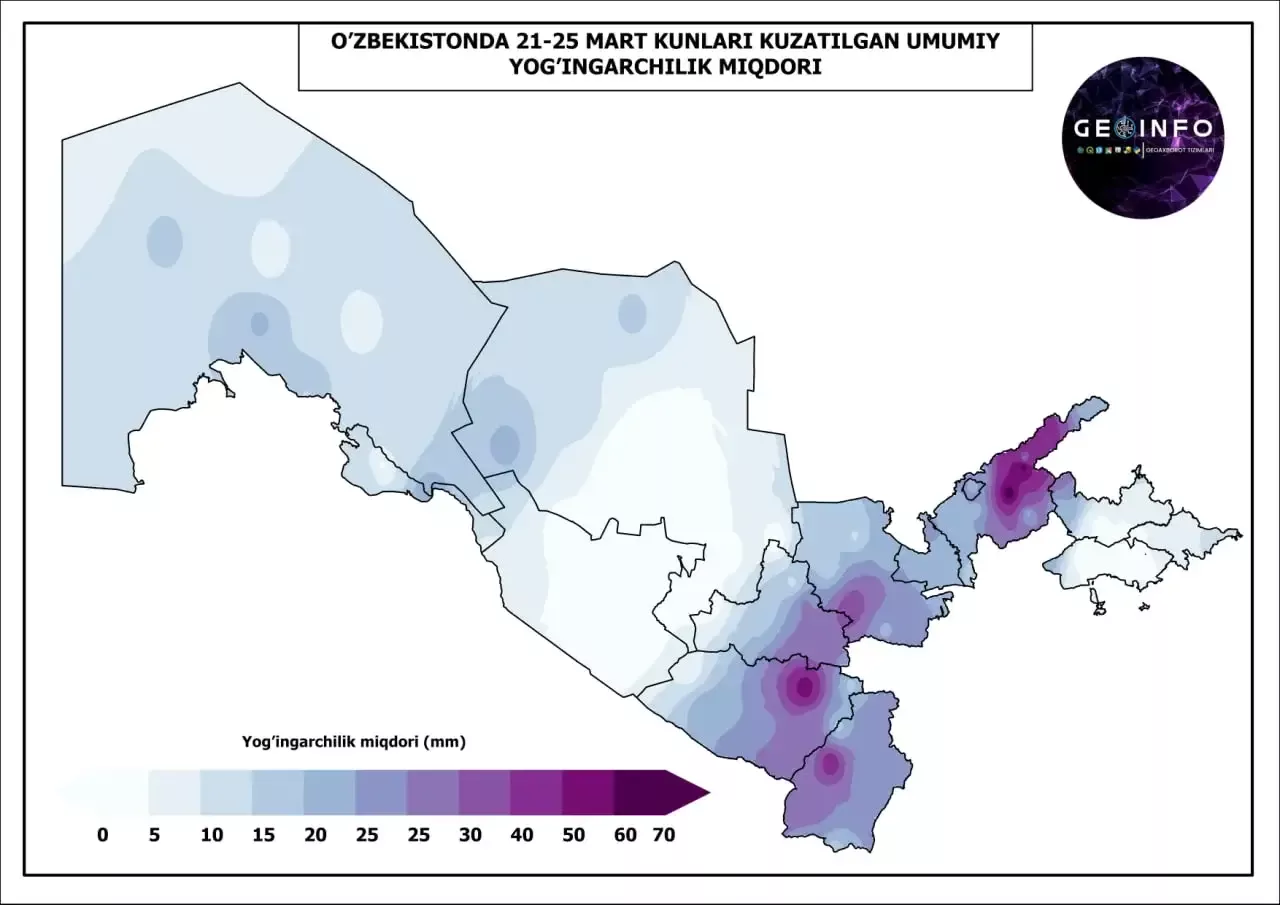
In March, it snowed, there was quite warm weather, and there were consecutive rainy days. So, what weather can farmers expect in April? What are the meteorologists saying?
Have the cold days ended?
This map shows how much precipitation fell in the republic from March 21 to 25.

Precipitation ranged from 0 millimeters to 70 millimeters across the republic over four days. There were areas where nearly 700 tons of water fell per hectare. The main precipitation was observed in our northern regions. For example, in some areas of Khorezm region, there was precipitation close to 200 tons, that is, up to 20 millimeters.
There was a slight discrepancy in our forecasts: we had predicted more precipitation in Bukhara region. However, in the main parts of Bukhara, during this period, precipitation was observed to be around 0-5 millimeters. In the western parts of Bukhara, however, there was considerable precipitation. A lot of precipitation was also observed in the northern areas of Navoi region. Anomalous precipitation was observed in the regions of Surkhandarya, Kashkadarya, half of Samarkand, Jizzakh, Syrdarya, and Tashkent regions.
In large areas of Surkhandarya, 40-50 millimeters, that is, close to 400-500 tons (per hectare) of water fell. This allowed not only cotton but also other types of seeds to be sown and easily germinated. Similar scenes were observed in Kashkadarya as well. In Samarkand, Jizzakh, and large parts of Tashkent region, precipitation ranged from 40-50 millimeters to 60 millimeters.
In Fergana region, however, it was less. Our forecasts were also around 0-15 millimeters. In the eastern areas of the valley, there was slightly more precipitation, close to 20 millimeters. This is not enough for many seeds to germinate. However, precipitation will continue. Now we are looking at March 26. There are also March 27-28, during which precipitation is expected in some places of the valley. However, the intensity of the rain has passed. Now, in some areas, precipitation expectations are up to 20 percent.
Now the question arises: "How did this precipitation affect the planting dates?" Precipitation was observed to be low in Bukhara. The current planting period does not match in the northern regions due to slightly lower temperatures. We are facing relatively low temperatures for Navruz. As for the temperatures, the days are gradually warming up. The European medium and long-term weather forecast model has provided a seven-day forecast. This forecast is from March 28 to April 4, and temperatures are expected to gradually rise from 20 degrees to 24, 28, and even 32 degrees.
At the beginning of April, there is a possibility that temperatures will rise to 30 degrees in many regions of the republic. Especially, warm temperatures are expected on April 2-3. This will set the optimal planting dates, allowing our farmers to start planting gradually based on soil moisture conditions after April 25. For the northern regions, this process is relevant for April 3, 4, and 5. Because temperatures of 30 degrees are expected.
In Karakalpakstan and Khorezm regions, cloudy processes are observed after precipitation, where the optimal planting date is considered to be after April 10. The World Meteorological Organization is forecasting temperature anomalies for April, May, and June.
According to this forecast, precipitation will be very low in Uzbekistan, Turkmenistan, Afghanistan, and the mountainous parts of Iran. The same is true for Tajikistan and Kyrgyzstan. This is a manifestation of the La Niña phase, as we mentioned in previous programs.
Climate forecasts predict a lot of precipitation in the southern region, including some areas of South Asia, India, and Pakistan, and a similar situation in some areas of Australia and Indonesia. Thus, the first week of April will be dry and hot, with little precipitation expected, while in the second week, precipitation will gradually begin, and temperatures above normal will be observed. In the third week, it will again be dry and above normal temperatures, meaning there is a possibility of several heat waves. In the last week of April, precipitation will be observed again, but not in large amounts. Planting work can gradually begin at the beginning of April or from the second decade.
- When talking about cotton planting, our observers are expressing concerns: they are asking us to provide information not only about cotton but also about other crops.
- Cotton is also a plant, and planting crops includes cotton as well. It depends on soil temperature. The same rules can be applied to other grain or vegetable crops. Cold-resistant crops, such as peas or potatoes, can be planted. Other types of crops, such as those similar to cotton, are planted in parallel.
- Listeners are asking us to continuously respond to questions...
- We are developing a bot and organizing the input of data into it. We need to use the information sent by the population so that our forecasts can prove themselves and we can know the expectations. The forecasts should manifest themselves and have an effect within the stated time, with this consideration we created the bot (Telegram bot address: @agro_meteo_bot). The bot is flexible not only for farmers but also for gardeners and amateur individuals. After entering the bot, first, a photo of the planting process is required. A photo is uploaded to see the soil condition of the planted area, then the region is specified, and the district is indicated. After that, cotton or other crops are specified. In the next section, information about crop types is written. Phone numbers are uploaded, and then the processes continue.
We receive that information, and in the next system, we want to involve our scientists in this project. We invite all our researchers to the project.
In the future, funding issues will be addressed. Because we are mobilizing resources and serving to make the work of our farmers easier.
- Can we consider this as a bot for combating climate change?
- Managing agriculture in accordance with climate and solving food security issues. Currently, this system exists in developed countries around the world, and we have now developed this system.